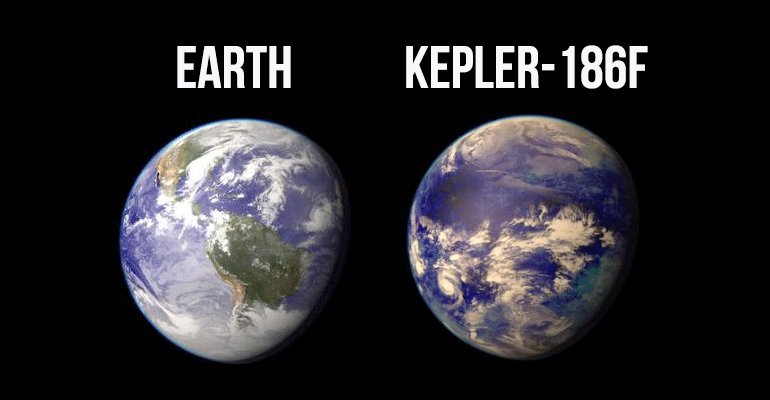
Kepler 186F compared to Earth
For the past three decades, the SETI Institute has been participating in a number of scientific explorations to answer the question "Are we alone?" Today, my co-authors and I are announcing the achievement of another milestone in the exploration.
We have confirmed the first Earth-sized planet orbiting in the habitable zone of a star other than the Sun.This planet is named Kepler-186f and it is one of five planets that have thus far been detected by NASA's Kepler space telescope in orbit about the star Kepler-186. This star is smaller and cooler than the Sun, of a type called an M-dwarf or red dwarf, and all its known planets are small as well, with sizes less than 1.5 times the size of Earth. The planet Kepler-186f is the smallest, being within 10% of the size of Earth and orbits furthest from the host star, within the habitable zone. This is the region around a star within which a planet can sustain liquid water on its surface given the right atmospheric conditions.
The Kepler-186 planetary system lies in the direction of the constellation Cygnus, about 500 light-years away.
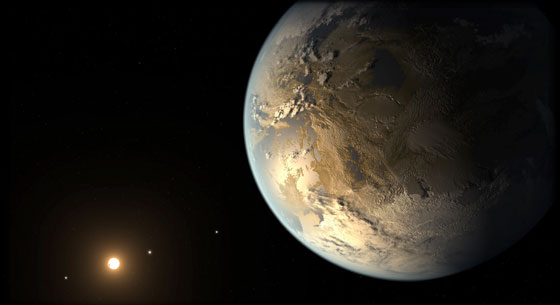
© NASA/Ames/JPL-Caltech/T. PyThe artist’s concept depicts Kepler-186f, the first validated Earth-size planet orbiting a distant star in the habitable zone—a range of distances from a star where liquid water might pool on the surface of an orbiting planet. Kepler-186f resides in the Kepler-186 system about 500 light-years from Earth in the constellation Cygnus. The discovery of Kepler-186f confirms that Earth-size planets exist in the habitable zone of other stars and signals a significant step closer to finding a world similar to Earth.
Previously, a small number of Earth-sized planets, such as Kepler-20e, have been discovered. However all previously known Earth-sized planets orbit close to their star, making them extremely hot and therefore inhospitable to life as we know it. About a dozen other planets have been found to orbit in their star's habitable zone, like Kepler-22b and Kepler-62f, however they are all larger than Earth, and many are thought to have a thick atmosphere of gas like Jupiter and Neptune rather than a solid surface. Kepler-186f is the first "Goldilocks" planet, it has the right size and orbits at the right distance, meaning if Kepler-186f is rocky like the Earth and has a suitable atmosphere, any water at its surface could be in liquid form.
The Kepler spacecraft measures the size of a planet by the fraction of starlight that it blocks as it transits across the face of the star. Planets in the habitable zones of M dwarfs are easier to detect than planets in the habitable zones of Sun-like stars because the proportion of starlight that they block is greater (Figure 2), leading to deeper transits.
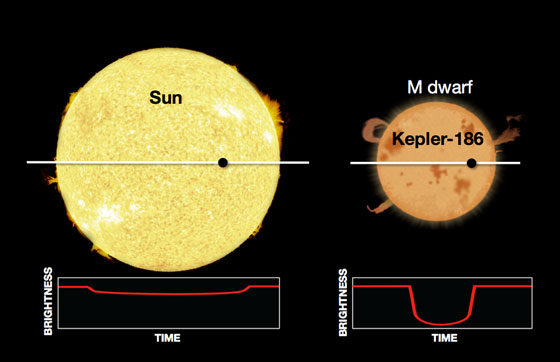
© Wendy StenzelAn Earth-sized planet crossing in front of a Sun-like star (left) and in front of an M dwarf like Kepler-186 (right). The amount of starlight blocked by an Earth-sized planet in the habitable zone of a Sun-like star is about four times less than the same planet transiting an M dwarf, making them easier to detect. (Download Full size image)
Because M dwarfs are cooler and dimmer than Sun-like stars, their habitable zones are located much closer in. The orbit of Kepler-186f (at 0.36 AU from its star, where 1 AU is the distance between the Earth and the Sun) fits just inside the orbit of Mercury (0.38 AU) in our Solar System. Planets in the habitable zones of M dwarfs therefore have shorter orbital periods than planets in the habitable zones of G dwarfs like our Sun, so many more transits are recorded over a fixed period of time. The combination of deeper and more frequent transits make M dwarfs prime targets in the search for potentially habitable worlds. Although the inner four planets were detected early in the Kepler mission (Kepler-186b, c and d with the first four months of data, and Kepler-186e with an additional year of data), these inner planets were validated in early 2014 by a team led by SETI scientist Jason Rowe using the "validation by multiplicity method" using the first two years of data. We only detected the fifth planet, Kepler-186f, when we analyzed three years of data, as this provided enough transits of this outer planet to achieve the statistical significance needed to verify it.
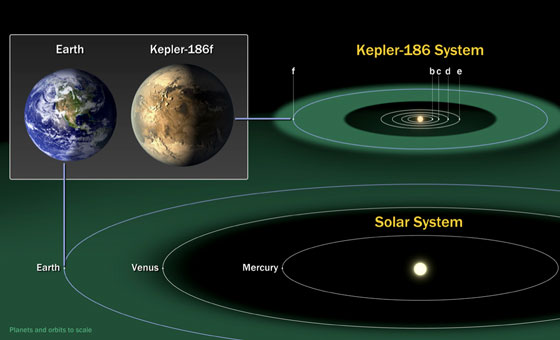
© NASA/Ames/JPL-Caltech/T. PyleKepler-186f is within ten percent the size of Earth. Kepler-186f orbits its star once every 130-days and receives one-third the energy that Earth receives from the sun, placing it on the outer edge of the habitable zone (shaded region in green). The system is also home to four inner planets, all smaller than 1.5 times the size of Earth. Because Kepler-186 is cooler and dimmer, the habitable zone is located closer in. All five planets in this system have orbital distances to their star less than Mercury’s distance to the Sun.
M dwarfs are very abundant, comprising about three quarters of the one hundred billion of stars in our galaxy; therefore most of the stars in the immediate vicinity of the Sun (where new observations and tests will be easiest) are M dwarfs. These stars also evolve very slowly in luminosity, so their habitable zones remain nearly constant for billions of years.
Since the Kepler transits measure a planet's size but not it's mass, we don't know the composition of Kepler-186f. However, we can roughly constrain the composition using theoretical models, which have shown that planets as small as Kepler-186f are unlikely to be dominated by a gas envelope like Neptune. There are two Earth-sized planets orbiting the Sun (Earth and Venus) and both bodies are primarily composed of some combination of rock, iron, water and ice. It is likely that Kepler-186f is also comprised of a combination of rock, iron, water and ice. Perhaps it even looks a bit like the artist's concept
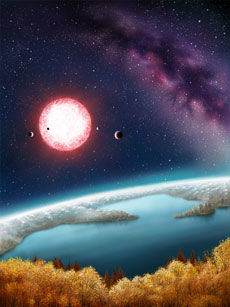
© Danielle FutselaarThe artist’s concept depicts Kepler-186f. If you were standing on the surface of this planet, the star would appear about 30% larger in the sky due to the proximity of the planet in the habitable zone to its star. M dwarfs emit much less visible radiation than our Sun, instead their flux peaks in the near-infrared, so plants might appear dark yellow or even black to absorb as much of the visible light as possible.
M dwarfs are known to be highly active early in their life, often producing giant and frequent flares that could scorch planets nearby. The M dwarf stars also gravitationally interact with their planets, causing tides that heat the planet and often cause their rotations to be 'tidally locked', which means one side always faces the star and the other side faces the cold open space, much like our moon is tidally locked with the Earth (we only see the "near side of the moon"). Fortunately, Kepler-186f orbits a fairly massive M dwarf star and it orbits at a large enough distance where it could very well have escaped many of the complications to habitability that M dwarfs may pose.
The next generation of space telescopes like Transiting Exoplanet Survey Satellite (TESS) will search for planets around M dwarfs that are nearby to us. The James Webb Space Telescope (JWST) will probe the atmospheres of these planets for biomarkers, which are chemical imprints of the signs of life that are detectable from a planets' atmosphere.
Since 2012, the SETI Institute's Allen Telescope Array in northern California, near Mt. Lassen, has been observing all reported Kepler candidate exoplanets in search of signals from extraterrestrial technological civilizations. This search is looking for patterns in frequency and time that could indicate an 'engineered' signal rather than natural radio emissions. The quiet, terrestrial microwave window from 1 to 10 GHz (where emission from astrophysical sources is minimum) is split into nine billion, narrow, one Hertz channels that are explored by automated, signal processing systems. For almost a month, the ATA has been focusing on the Kepler-186 system, with the Earth-size Kepler-186f in the habitable zone. The ATA has observed all frequency channels from 1 to 10 GHz twice. To date, all signals that have been detected can be attributed to Earth's own technology. At the distance of Kepler-186 (about 500 light years), a signal would have to have an effective, isotopic radiated power that is 10 to 20 times as powerful (depending on the frequency) as the signal from the planetary radar transmitter on the Arecibo Observatory, Earth's strongest transmitter.








Avatar's Pandora or Contact of Carl Sagan's fame anyone??? Hmm:-)